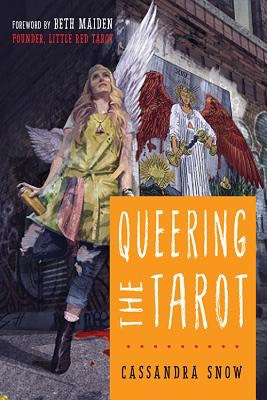Review by Allan Ritchie

Written by Cassandra Snow
Forward by Beth Maiden
ISBN-13: 9781578636488
When “Queering the Tarot” was suggested by my Amazon account as a recommended book it caught my attention. It doesn’t take much for me to become interested in Tarot so I took a look. Also, the cover image was the Temperance card from Robin Scott’s Urban Tarot which had been on my wish list also caught my eye. When I saw it was going to be released on one of my days off, I quickly preordered it for my Kindle.
I have been working with the Tarot for a while now. I was pretty comfortable in how I understood and comprehended the Tarot. Reading “Queering the Tarot” was breath of fresh air and was equally as challenging. It was an awakening to realize how blinded I was with many aspects to the cards. I grew up and continue to live in a very conservative community. Tarot was my inward rebellious act of nonconformity. I assumed that it was safe to think, to assume that like many in the Tarot community I have considered myself open-minded, accepting, and progressive in my thinking. Cassandra, in this book took me by the hand and showed me that I didn’t have a clue and I needed to expand my thinking. I read the entire book cover-to-cover in a single day and it was one of the most important days in my Tarot practice.
The structure of the book is standard when compared to other Tarot books. A bit of an introduction about the purpose or reason for the book then a card by card description of the meaning for the cards. This is a tried and true method of Tarot writing that I feel will never go out of style while it might lack a sense of freshness at times. Here in this book, it works well as the Foreword and initial sections shape the discourse of the rest of the book. The introduction started with a bit of a wake-up call for me. In the section called “Word,” It is clear that Cassandra to be inclusive and honoring of all genders and sexualities. The acronym LGBTQQIP2SA+ (Lesbion, gay, bisexual, transgender, queer, questioning, intersex, pansexual, two-spirit, asexual, and other gender and sexual minorities) is used throughout the book. It is a mouthful and at first a hard concept to wrap my head around. Yes, I have known that there is a wide spectrum of sexualities and genders but in this one page of print, Cassandra touched on the heart of identity and what it means to feel included. But also there was a sense that there is still divisiveness even in this attempt to be inclusive.
The argument that a Tarot deck is a rebellious and empowering book and a Tarot reading is a resource for those who marginalized in society it cogent and powerful. Tarot is a tool for claiming the power in our own lives. When Beth Maiden in the Foreword asserts that a deck of Tarot card is part of the queer cannon, I began to pay more attention. The idea of a Tarot deck being a book on its own is not a new one. Yet here it was asserted that the Tarot is a part of the fundamental understanding of identity and self in a marginalized position.
“Queering the Tarot” excels as a book for those of us who have not been as aware of how many of the archetypes of the Tarot can be encountered by those who are marginalized by society. The section on the Empress and the Emperor hit me hard as I have been wildly ignorant of the impact that the drastic binary nature of these two cards can have on others. Growing up in a heteronormative father-mother family as a cis-gendered male I was oblivious to how I saw these two cards as proscriptive “Mother” and “Father” cards could be damaging to others. These iconic representations of parentage have long been ingrained in my consciousness as primary if not the ideal family situation. Conceptually, I of course understand that this is an outdated idea and does not reflect the current reality. Yet here I was confronted with the idea that for some this very identification with the binary can be hurtful. We have seen Tarot decks begin to show more diversity in expressing the human condition but I have always seen as something to be celebrated, supported and encouraged. “Queering the Tarot” challenged me to continue to be aware of my understanding of the archetypes is not the same as others have seen them. When I have a great relationship with my parents then transfer that positive feeling on to the Empress and the Emperor as archetype that can be a disconnection for a client who does not see it in the same way.
“Queering the Tarot” may not be as groundbreaking for some as it was for me. In a world where we all to need remember that we all have our own personal perspective on life and it isn’t the same for everyone else; this book gave me the chance to see it through a completely new lens and understanding. This book gave me deeper insight and appreciation for the Tarot. I have known the power of a deck to transform a life but reading this book I am encouraged even more that there are those who find their way to Tarot and this book will begin to see that they are valid